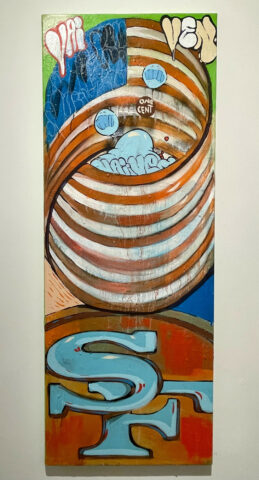Growing up in the Mission, visual artist Josué Rojas still remembers the vibrant fruterias of the neighborhood, plastered with advertisements for sugar-infused treats, soda pop, and ice cream. These ads, both hand-painted and printed, fused with the emergence of graffiti counter-culture that swept through San Francisco in the 80’s and 90’s.
This urban palimpsest is thoughtfully encapsulated in Rojas’s fifth major solo exhibition, “Central American Pie,” now on display at The Incline Gallery. In his unique collection of paintings, Rojas remixes U.S. advertisements and Americana imagery with Central American iconography, symbols, and folklore—all laced with elements of graffiti and urban street art. The resulting mashup is a reflection on culture and consumerism back when advertisements infiltrated street life, decades before the ubiquity of cellphones and algorithm-driven digital ads.
Rojas blends acrylic, spray paint, and ink drawings into pieces that show how the U.S. intersects with Central America. He calls this intersection “Vai Ven,” a Spanish term that translates to “come and go” in English, referring to the ebb and flow of people or things and highlighting a sense of motion and change. To Rojas, who migrated from El Salvador as a child, this phrase describes the transient nature and back-and-forth dynamics he experienced in his personal life growing up as a Central American in San Francisco. Serving as a motif, “Vai Ven” can be spotted across several of Rojas’s paintings etched in graffiti.

In the show, Rojas transforms old cartoons into new ones that distinctly represent the U.S. Central American experience. For instance, he reimagines the classic American cartoon character Felix the Cat as a joyful Platano (not to be confused with a banana). Another character known as “Pupusa Face” resembles Astro Boy with a proud and round smiley face inside a Salvadoran pupusa with cheese dripping out. A plump pineapple with a smiley face is also joyfully resting amid a tropical paradise.
“I want people from different walks of life to have an entry point,” said Rojas. “A graffiti writer will look at this and have an entry point. A child would look at the cartoons and have an entry point. I think a Central American would look at these national birds and have an entry point.”
“Central American Pie” was inspired by the 1971 song “American Pie” by Don McLean. The song pays tribute to early rock and roll musicians who died in a plane crash on February 3, 1959, referenced in the song as “the day the music died.” Among the three musicians killed was Richard Steven Valenzuela, better known as Ritchie Valens, who was born in the U.S. to Mexican parents. Valens was a pioneering figure who seamlessly wove Mexican musical influences into the fabric of American rock and roll, challenging and expanding its definition.


By blending “Central” into “American Pie,” Rojas’s perspective sheds light on a critical aspect of cultural history: the Latin American and Latinx influences that are intricately but often invisibly woven into the broader narrative of mainstream America. It prompts viewers to ask, where do Latinx artists fit into the larger world of U.S.-American art?
“I wouldn’t be versed in America if it hadn’t come to my country and come to me,” said Rojas, who fled Central America during the Salvadoran civil war. “Now we’re in a post-war reality in a time of surfing and Bitcoins, iPhones, and TikTok. These are all political forces shaping our world, and I’m trying to make sense of it as much as anybody else.”
Through his art, Rojas makes a poignant critique about U.S. military involvement in Central American struggles. By providing substantial funding and resources to civil wars in Nicaragua, El Salvador and Guatemala, many Central Americans, including Rojas, were displaced and forced to migrate to the U.S. and other countries. In “Central American Pie,” Rojas invites viewers into a hybrid world from El Salvador to San Francisco, and back again, weaving a complex history of past, present, and future.

The exchange between the U.S. and Central America is a two-way street. Through his playful visual art, Rojas highlights that these cultural dynamics have longer histories than often portrayed. The exhibition is a compelling mix of nostalgia and critique, a dynamic confrontation of past influences and present realities. This juxtaposition serves as a reminder of the fluidity of cultural boundaries and the continuous shaping of identity through personal and collective histories.
As such, “Central American Pie” is a must-see for those who appreciate art that challenges, delights, and inspires dialogue about history, identity and the impact of cultural exchange.
“Central American Pie” by Josué Rojas now on view at The Incline Gallery at 766 Valencia Street in San Francisco until July 14, 2024.


